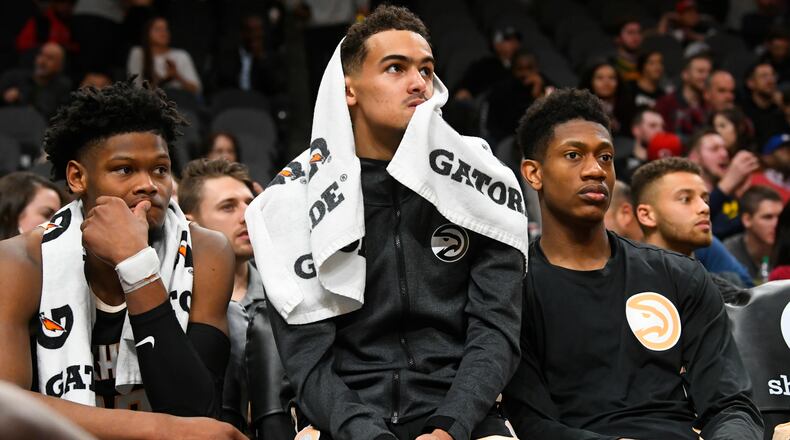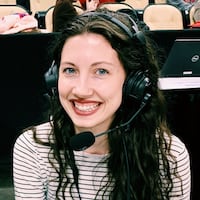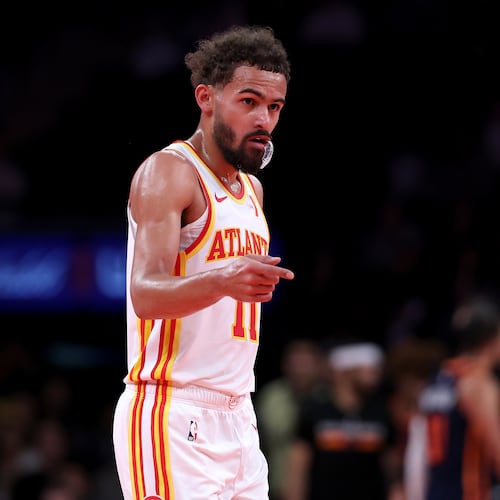With aggressive moves in free agency, the Hawks have gone from a team with glaring depth issues and a struggling second unit to a team so deep it’s difficult to predict an exact starting lineup.
Outside of purely adding talent, the depth of the roster has made realistic the Hawks’ hopes of going from 20-47 last season — so low in the Eastern Conference standings at the time of the season’s suspension they were excluded from the Orlando, Fla., bubble — to playoffs contenders in 2021.
Even before last season, the Hawks received a little playoff buzz as a young and exciting team. But, after John Collins was suspended Nov. 5 and Kevin Huerter injured his shoulder one week later, it quickly became clear they simply didn’t have enough pieces in place to win many games.
Bottom line, outside of the team’s “Core Five” players — Trae Young, Collins, Huerter, Cam Reddish and De’Andre Hunter — the Hawks didn’t have enough depth to be competitive. They spent the majority of the 2019-20 season searching for answers at backup point guard and center and didn’t have enough 3-point shooting or players who could defend at a high level. They had to give too many minutes to 43-year-old Vince Carter — a valuable mentor to the young players They took on bad contracts in exchange for assets, and those additions — Evan Turner, Allen Crabbe, Chandler Parsons — couldn’t effectively contribute.
Credit: Curtis Compton
Credit: Curtis Compton
With several moves this offseason there’s been a significant roster upheaval. Outside of Young as the go-to point guard and Clint Capela as the go-to center, and probably Bogdan Bogdanovic as the go-to backcourt pairing with Young, the team’s rotations and breakdown of minutes is a bit of a question mark. From a team perspective, that competition is a good problem. It’s a direct result of the Hawks improving and trying to win now, not just develop for the future.
A breakdown of those moving parts:
They added Bogdanovic, Danilo Gallinari, Kris Dunn, Rajon Rondo and Solomon Hill in free agency, added Tony Snell via a trade that sent Dewayne Dedmon to the Pistons and renounced the free-agent rights for DeAndre’ Bembry, Charlie Brown Jr., Vince Carter, Treveon Graham, Damian Jones, Skal Labissiere and Jeff Teague.
The Hawks needed help with shooting: Gallinari is an excellent shooter. Bogdanovic is a good shooter, too. Snell shot 40.2% from 3 over the last four years, on average.
The Hawks needed help with defense: Dunn is an excellent defender. Rookie Onyeka Okongwu projects as a versatile, strong defender.
The Hawks needed help with their second unit: Rondo is a good passer, can be a secondary ballhandler behind Young and has an extremely high basketball IQ.
As of now, it looks like the Hawks will carry eight players over from last season’s team: Young and Huerter, who will enter Year 3; Reddish, Hunter and Bruno Fernando, going into Year 2; and Collins, who is up for an extension entering Year 4. Both Collins’ camp and the Hawks are hopeful to get a deal done, with still another year remaining on his contract. Then there’s backup guard Brandon Goodwin, who started out last year as a two-way player but was converted to an NBA contract, and Capela, who is finally healthy and ready to make his debut after being acquired from the Rockets at the trade deadline.
The team added picks No. 6 Okongwu and No. 50 Skylar Mays via the draft and signed Nathan Knight to a two-way contract. Mays, too, will be on a two-way deal.
If they do not make any other moves, they’re right at 15 players with two two-way guys.
Credit: Curtis Compton
Credit: Curtis Compton
Who will start? What will lineups look like?
Good question. Lloyd Pierce could go a few different directions with this, and that’s the first time as coach of the Hawks that he’s had that kind of flexibility.
A team’s starting rotation is not everything and can fluctuate depending on need, injuries and how players mesh and develop, but on first instinct, it could make sense for a lineup of Young, Bogdanovic, Hunter/Reddish, Collins and Capela to start. Given his contract, bringing Gallinari, 32, off the bench seems far-fetched, but if the Hawks still have Collins, Collins is a better rebounder and defender who averaged 21.6 points per game last season, leading the team in 3-point percentage (40.1%).
That leaves Rondo/Goodwin/Mays at PG, Huerter/Dunn/Reddish/Mays at SG, Reddish/Hunter/Snell at SF, Gallinari/Hunter/Hill at PF and Okongwu/Fernando/Knight at C to work with.
It’ll be interesting to watch how Pierce can take advantage of this team’s abilities on offense while still making sure the lineup is strong enough defensively. Gallinari and Young struggle on defense. Rondo is not what he once was. Neither Huerter nor Bogdanovic are impressive defenders as of now. Collins improved last year but is still not the strongest defender.
But Dunn can be mixed in to help, as one of the best guard defenders in the league who can match up well with some top players who cooked the Hawks last season. Okongwu, who will start out primarily playing center, may eventually be able to flash to power forward. Defensively, Capela will be a vast improvement for the Hawks at center. He has expressed excitement about bringing a defensive voice and winning mindset. If Reddish and Hunter can take a step forward defensively, that will give the Hawks a major boost on that end of the court.
Credit: Atlanta Hawks
Credit: Atlanta Hawks
What does this mean for the young guys?
It’s certainly true that developing Hawks players will have to earn their minutes more this year. They’ll be competing against players who are more experienced and more polished.
In August, general manager Travis Schlenk talked about how the team’s top draft pick would have to compete for playing time as opposed to automatically stepping into it.
“I think it’ll be more of a situation where you have to earn as opposed to be given, which is good, and the same for the guys that are on our roster,” Schlenk said. “(If) we end up getting a player and you know what, he’s earned it, he’s going to get it. So I think that’s a positive, I don’t view that as a negative at all.”
There will still be roles for the young and developing guys, but obviously no one likes to see their playing time diminish, and it’s realistic there could be frustration over that. That’s something to keep an eye on, if any were to grow unhappy with their situation.
But, players can still learn and grow even if they’re not starting, whether that’s through practice, the minutes they get being more meaningful, input from veterans, etc. Not every single guy can start, and if the team stays this deep, some strong talent will be coming off the bench — the good news is, if they can excel in that role, the Hawks’ second-unit struggles will be a thing of the past.
In Reddish and Hunter, the Hawks had two rookies playing heavy minutes last year, with mixed results. Hunter (32 minutes per game) was up-and-down as both a shooter and defender, Reddish (26.7 minutes per game) was a relatively steady defender but his offense was nowhere to be found until around January, when his shooting took off. Those two may have to compete for time at the 3, depending on how the roster settles by the time Dec. 22 rolls around. It may make sense for Hunter to play the 4 in some lineups.
Huerter plays the same position as Bogdanovic, so he’ll have to compete for time, as well. Last year, Huerter struggled with a nagging knee injury for the most of the season and missed 11 games after he strained his left rotator cuff in November. He played through the knee injury, but it held him back and he didn’t look like himself until late December or so.
Huerter (31.4 minutes per game last season), known for his 3-point shooting though he’s actually pretty versatile, shot a little bit better than Bogdanovic from 3 (38% to 37.2%), but Bogdanovic averaged 15.1 points to Huerter’s 12.2. Both pass well, both rebound well. Bogdanovic gets to the rim more. Huerter can play backup point guard, too, though Rondo now figures to handle that responsibility.
Whatever Huerter’s role looks like, staying healthy for him will be key, as will adding another layer to his game, finishing through contact and getting to the free-throw line more.
Will the Hawks make the playoffs?
Barring unforeseen injuries, they have the talent to do so, yes.
There are a few potential fit issues on this team, from what happens with Gallinari and Collins at power forward, to how much the defense can truly improve, to how the second unit comes together, to how minutes will ultimately be distributed. We still haven’t even seen how Collins and Capela fit together.
It’s possible all of that goes smoothly, the Hawks shoot the lights out of the ball, team defense takes a step forward and Atlanta is back in the playoffs for the first time since the 2016-17 season. We’ll have to wait until Dec. 22 to get a feel for how this team will come together.
But they’ve certainly got enough firepower, depth and potential to be a threat in the Eastern Conference.
About the Author
Keep Reading
The Latest
Featured





